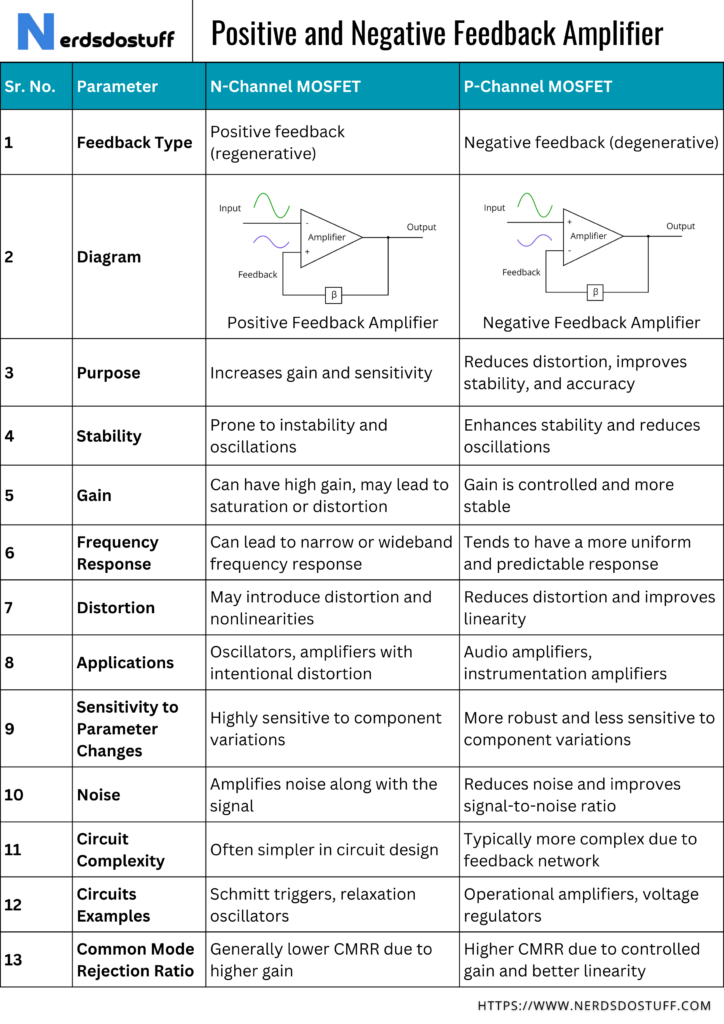What is Positive Feedback Amplifier ?
A positive feedback amplifier is a circuit in which a fraction of the output voltage is fed back to the input with the same polarity, reinforcing the input signal. This regenerative feedback results in an increase in the overall gain of the amplifier. Positive feedback amplifiers are characterized by their ability to boost signal amplitudes and sensitivity. However, they are prone to instability, oscillations, and saturation due to the cumulative reinforcement of the input signal. Positive feedback amplifiers are commonly employed in applications like oscillators, where sustained oscillations are desired, or in circuits where intentional distortion and nonlinearity are required, such as in Schmitt triggers and relaxation oscillators.
What is Negative Feedback Amplifier?
A negative feedback amplifier is a circuit in which a portion of the output voltage is fed back to the input with an inverted (negative) polarity, opposing the input signal. This degenerative feedback serves to stabilize and control the amplifier’s performance by reducing gain, minimizing distortion, and improving linearity. Negative feedback amplifiers are widely used in various applications, including audio amplifiers and instrumentation amplifiers, where accuracy and fidelity are crucial. By trading some gain for increased stability and reduced distortion, negative feedback amplifiers provide a more predictable and controlled amplification process. This type of feedback helps maintain desired operating conditions and enhances the overall performance and reliability of the amplifier circuit.
Difference between Positive and Negative Feedback Amplifier
Text
| Sr. No. | Parameter | Positive Feedback Amplifier | Negative Feedback Amplifier |
|---|---|---|---|
| 1. | Feedback Type | Positive feedback (regenerative) | Negative feedback (degenerative) |
| 2. | Purpose | Increases gain and sensitivity | Reduces distortion, improves stability, and accuracy |
| 3. | Stability | Prone to instability and oscillations | Enhances stability and reduces oscillations |
| 4. | Gain | Can have high gain, may lead to saturation or distortion | Gain is controlled and more stable |
| 5. | Frequency Response | Can lead to narrow or wideband frequency response | Tends to have a more uniform and predictable response |
| 6. | Distortion | May introduce distortion and nonlinearities | Reduces distortion and improves linearity |
| 7. | Applications | Oscillators, amplifiers with intentional distortion | Audio amplifiers, instrumentation amplifiers |
| 8. | Sensitivity to Parameter Changes | Highly sensitive to component variations | More robust and less sensitive to component variations |
| 9. | Noise | Amplifies noise along with the signal | Reduces noise and improves signal-to-noise ratio |
| 10. | Circuit Complexity | Often simpler in circuit design | Typically more complex due to feedback network |
| 11. | Circuits Examples | Schmitt triggers, relaxation oscillators | Operational amplifiers, voltage regulators |
| 12. | Common Mode Rejection Ratio | Generally lower CMRR due to higher gain | Higher CMRR due to controlled gain and better linearity |
Image





